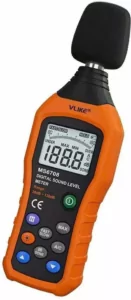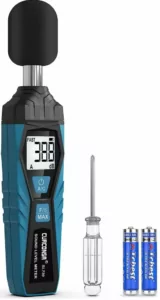Noise in the classroom can prove disruptive to the learning environment, a problem that many educators grapple with on a daily basis. By transforming sound into a visible indicator, teachers can cultivate a more noise-aware environment where students are encouraged to monitor their own volume levels.
Classroom noise meters, a suite of tools and apps designed for this purpose, are an excellent way to mitigate disruptive classroom sounds and foster an environment conducive to education.

These noise meters, which we have compiled into a list of some of the most highly recommended options, offer an uncomplicated, affordable, and user-friendly solution to the noise problem. They enable a better learning experience by reducing classroom noise levels.
However, it is important to note a potential caveat raised by some educators – the possibility of these noise meters becoming a source of distraction. For instance, some teachers, particularly those who work with students with special needs, have reported that the alarm sounds and visual cues (like bouncing balls) can be more distracting than helpful, as they tend to divert attention from the lesson at hand (read teachers feedback in this Facebook post).
Ironically, these tools, designed to enhance focus by managing noise, can sometimes have an adverse effect, compromising concentration rather than aiding it. This necessitates a prudent approach to their use.
If you observe any discomfort or distraction among your students, it might be better to forgo these tools and lean towards more traditional, non-tech methods of noise management. This way, you ensure the learning environment is comfortable and beneficial for every student.
Best noise and sound meters on Amazon
If you are looking for physical noise meter products, here are 3 of the top rated meters in Amazon. I already reviewed them in a separate post if you want to learn more about them. These are:
Online Classroom noise meters
Here are our top picks for online classroom noise meters:
1. Bouncy Balls
Bouncy Balls is a free web tool that helps you manage your classroom noise. Bouncy Balls has an integrated noise meter that automatically detects different noise levels in surrounding environment and sends off alert signals.
Bouncy Balls is completely free, requires no registration or software download, and most importantly, is simple and easy to use. I have already written a review of this tool which you can read in Bouncy Balls: A Good Tool for Managing Classroom Noise.
2. Classcraft Volume Meter
Classcraft includes an integrated noise meter which allows you to monitor the noise in your classroom. The way it works is simple: determine a noise baseline in your classroom by setting the noise meter to a specific volume. A horizontal bar displays the fluctuations of the noise allowing students to visualize their noise in real time.
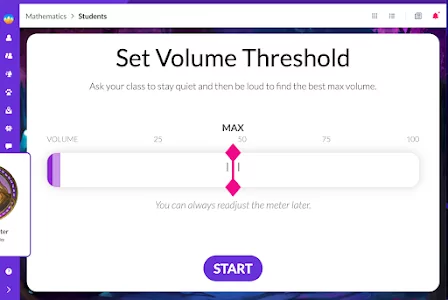
Classcraft Volume Meter is free and can be used without registration. It also includes a timer to help you time your classroom activities. Premium users have access to more features including an advanced reward system.
3. Classroom Noise ‘O’Meter
This is another good noise meter for classroom. It is basically a coding project created using the popular coding platform Scratch.
To start using Noise’O’Meter you need to turn on your computer’s microphone. Noise’O’Meter takes the shape of a clock with a single hand that moves clockwise according to the noise level.
The tool uses a colour intensity system to tag noise levels starting with low levels (green colour) all the way to highest noise levels (red colour).
And since Scratch is a collaborative community-based coding platform, members of the community have used Noise’O’Meter in their own projects creating what is known in Scratch lingo as Remixes. You can find these remixed projects on the right hand side within the tool’s homepage.
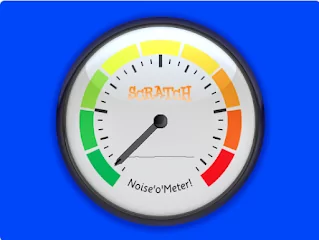
4. ClassDojo
ClassDojo is a classroom management website that helps teachers track and manage students behaviour. ClassDojo includes an integrated noise meter for classroom.
The meter consists of a Sensitivity bar that you can adjust to your preference and bouncing columns that fluctuate according to noise level.
You need to log in to your account to start using ClassDojo’s noise meter. Once logged in, click on Toolkit and select Noise Meter. Set a noise limit using the sensitivity bar, turn on the microphone of your device, and voila! You are all set.
5. Too Noisy
Too Noisy is a noise level meter that you can use in your class to help with monitoring and managing the noise of your students. Too Noisy works on Android, iPhone, iPad, and online.
Some of the features provided by this noise meter app include: visual backgrounds that change with changing noise levels, alarm counter that can be turned on and off, star rewards to reward students for keeping their noise under or within the acceptable range, and more.
Another cool feature offered by Too Noisy is that when students go over the predetermined noise threshold for over 3 seconds, “an audible alarm is sounded (this can be turned on and off) and the screen of the device appears to shatter!
Also, the “Alarm Counter” on the meter is incremented by one (this can be zeroed at any time with a reset button).”
6. Classroomscreen Sound Level
Classroomscreen offers this handy noise meter to use in your classroom. Sound Level is a widget you can access from Classroomscreen homepage. It allows you to use the microphone of your device to control the noise level in your classroom.
Use the integrated slider to set a noise threshold for your students. When students surpass the permitted level the bell rings alerting them to keep quiet.
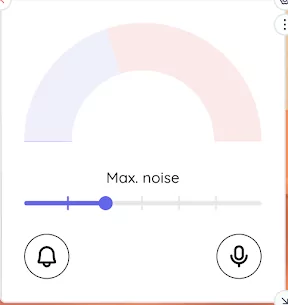
You can also use the settings of the Sound Level to adjust microphone sensitivity and, in case you have multiple mics, select the microphone you would like to connect.
You can also change the color theme of the widget by selecting a pre-designed theme from the library or by adding your own color theme.
Bottom line
And there you have it, folks—a rundown of some pretty nifty classroom noise meters that every teacher should consider integrating into their learning environments. Let’s face it, managing classroom noise is one of those subtle arts in teaching that can either make or break an instructional moment. It’s not just about keeping things quiet; it’s about creating an environment conducive to focus, discussion, and active learning.
From my own time in the classroom, I’ve seen how a simple visual cue like a noise meter can serve as an excellent self-regulation tool for students. They instantly get the feedback they need without you halting your lesson to say “shhh” for the umpteenth time. And for us teachers, these gadgets provide that extra layer of data to understand our classroom dynamics better.
If you’re thinking of blending tech with classroom management, these noise meters could be your starting point. They’re practical, user-friendly, and let’s admit it—a little fun, too. So, whether you’re teaching rowdy first-graders or chatty high-schoolers, give one of these a go and let me know how it impacts your classroom atmosphere.



